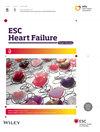Decoding anthracycline- and trastuzumab-related cardiac dysfunction prediction: HFA-ICOS scores versus strain imaging
Abstract
Aims
Baseline Heart Failure Association–International Cardio-Oncology Society (HFA-ICOS) scores and serial left ventricular global longitudinal strain (LV-GLS) measurements have been found to be useful in predicting cancer therapy-related cardiac dysfunction (CTRCD). However, their integration for the purpose of improving prognostic accuracy remains unclear; and we aimed to develop a predictive model for CTRCD using baseline HFA-ICOS scores and the relative decline of LV-GLS in patients on anthracycline or trastuzumab.
Methods
We prospectively enrolled 443 chemotherapy-naïve women with breast cancer and cardiovascular risk factors, scheduled to receive anthracycline (n = 333) or trastuzumab (n = 110). Participants were stratified by the HFA-ICOS risk score. The left ventricular ejection fraction (LVEF) and LV-GLS were evaluated using echocardiography at baseline, before each treatment cycle, and every 3 months in the first year post-chemotherapy. CTRCD was a new LVEF reduction ≥10 percentage points to an LVEF < 50%, irrespective of symptoms.
Results
In terms of HFA-ICOS stratification, 258 patients (58.2%) were low risk, 180 (40.6%) were moderate risk and 5 (1.2%) were high risk. The proportions of low- and moderate-risk patients were similar in the anthracycline and trastuzumab groups. Twenty-four (7.2%) and seven (6.4%) patients treated with anthracycline and trastuzumab, respectively, displayed asymptomatic CTRCD. The addition of the baseline HFA-ICOS risk score did not improve the performance of the significant relative decline of LV-GLS > 15% in predicting both anthracycline [area under the receiver-operating characteristic curve (AUC) 0.93, 95% confidence interval (CI) 0.89–0.96, sensitivity 87.5%, specificity 93.2%] and trastuzumab (AUC 0.97, 95% CI 0.88–0.99, sensitivity 85.7%, specificity 93.2%)-related cardiac dysfunction.
Conclusions
Contemporary anthracycline and trastuzumab-based regimens resulted in similarly low incidences of CTRCD. In this context, LV-GLS evolution was the best predictor of CTRCD.


 求助内容:
求助内容: 应助结果提醒方式:
应助结果提醒方式:


